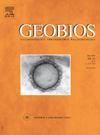微ct重建揭示了早白垩世伊比利亚鸟系统发育位置和运动的新信息
IF 1.6
4区 地球科学
Q2 PALEONTOLOGY
引用次数: 0
摘要
西班牙Las Hoyas下白垩纪遗址发现的对鸟目伊比利亚鸟(Iberomesornis romerali)早在35年前就被发现了。作为已知的该分支的第一个关节部分骨骼之一,romerali对我们理解早期鸟类系统学至关重要。由于其保存在很大程度上是二维板标本,以前的解剖描述无法完全捕获其解剖结构。在这里,我们提出了新的解剖数据基于微型计算机断层扫描的全型。我们重建了五个以前鲜为人知的骨元素,即颈椎,幽门骨,喙骨,骨阜和肱骨。对这些元素进行重新评价后,修订了鸟类枝系分析常用的15个形态特征的评分。修改后的特征矩阵结果支持Iberomesornis在反鸟目中的派生位置,接近长翅目。此外,在喙骨和肱骨的新发现显示了发达的肌肉,用于提升(即,喙上肌)和屈伸(桡侧腕伸肌)的翅膀。新的证据,连同典型的反鸟目叉形和小尺寸的全型,表明罗默拉利有能力拍打飞行。本文章由计算机程序翻译,如有差异,请以英文原文为准。
Micro-CT reconstruction reveals new information about the phylogenetic position and locomotion of the Early Cretaceous bird Iberomesornis romerali
The enantiornithine Iberomesornis romerali from the Lower Cretaceous site of Las Hoyas (Spain) was originally described more than 35 years ago. As one of the first known articulated partial skeletons of this clade, I. romerali has been critical to our understanding of early avian systematics. Due to its preservation as a largely two-dimensional slab specimen, previous anatomical descriptions were unable to fully capture its anatomy. Here, we present new anatomical data based on micro-computed tomography of the holotype. We reconstruct five previously poorly known osteological elements, i.e., cervical vertebrae, pygostyle, coracoid, furcula, and humerus. Re-evaluation of these elements resulted in revised scorings for 15 morphological characters commonly used for cladistic analysis of Aves. The results of the modified character matrix support Iberomesornis in a derived position within Enantiornithes, close to the Longipterygidae. In addition, new findings in the coracoid and humerus reveal well-developed muscles for the elevation (i.e., supracoracoideus) and flexion–extension (extensor carpi radiale) of the wing. The new evidences, together with the typical enantiornithine furcula and the small size of the holotype, suggest that I. romerali was capable of flapping flight.
求助全文
通过发布文献求助,成功后即可免费获取论文全文。
去求助
来源期刊

Geobios
地学-古生物学
CiteScore
3.30
自引率
6.20%
发文量
28
审稿时长
6-12 weeks
期刊介绍:
Geobios publishes bimonthly in English original peer-reviewed articles of international interest in any area of paleontology, paleobiology, paleoecology, paleobiogeography, (bio)stratigraphy and biogeochemistry. All taxonomic groups are treated, including microfossils, invertebrates, plants, vertebrates and ichnofossils.
Geobios welcomes descriptive papers based on original material (e.g. large Systematic Paleontology works), as well as more analytically and/or methodologically oriented papers, provided they offer strong and significant biochronological/biostratigraphical, paleobiogeographical, paleobiological and/or phylogenetic new insights and perspectices. A high priority level is given to synchronic and/or diachronic studies based on multi- or inter-disciplinary approaches mixing various fields of Earth and Life Sciences. Works based on extant data are also considered, provided they offer significant insights into geological-time studies.
 求助内容:
求助内容: 应助结果提醒方式:
应助结果提醒方式:


